Cite this document
(The Nature of Satyagraha Research Paper Example | Topics and Well Written Essays - 2750 words, n.d.)
The Nature of Satyagraha Research Paper Example | Topics and Well Written Essays - 2750 words. Retrieved from https://studentshare.org/philosophy/1739360-there-are-multiple-topics-listed-in-the-document-choose-one
The Nature of Satyagraha Research Paper Example | Topics and Well Written Essays - 2750 words. Retrieved from https://studentshare.org/philosophy/1739360-there-are-multiple-topics-listed-in-the-document-choose-one
(The Nature of Satyagraha Research Paper Example | Topics and Well Written Essays - 2750 Words)
The Nature of Satyagraha Research Paper Example | Topics and Well Written Essays - 2750 Words. https://studentshare.org/philosophy/1739360-there-are-multiple-topics-listed-in-the-document-choose-one.
The Nature of Satyagraha Research Paper Example | Topics and Well Written Essays - 2750 Words. https://studentshare.org/philosophy/1739360-there-are-multiple-topics-listed-in-the-document-choose-one.
“The Nature of Satyagraha Research Paper Example | Topics and Well Written Essays - 2750 Words”, n.d. https://studentshare.org/philosophy/1739360-there-are-multiple-topics-listed-in-the-document-choose-one.


